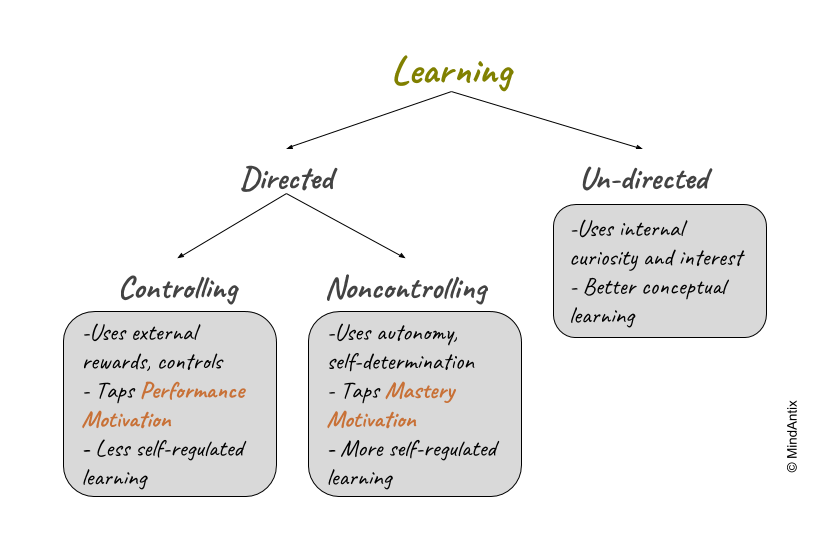In an interesting study to understand the relationship between motivation and learning, researchers gave elementary students a reading comprehension task. One group was explicitly told that they were going to be tested and graded on what they learned at the end of the activity, while the others were not.
The results of the experiment revealed a lot about the interplay between learning, motivation and rewards. Students who were told that they would be tested and graded, found the reading task less interesting and felt more stress compared to the others. Their assessment afterwards also showed an interesting pattern. They performed as well as the other groups, but only when limited to rote information. Conceptual integration of the material was poorer than the other groups. In addition, one week after the experiment, they had forgotten more information compared to other groups! As the researchers concluded, “It is not unreasonably speculative to argue that grades as traditionally used in schools often result in the perception of an external locus of causality, produce pressure, and result in force-fed, poorly integrated and maintained learning.”
So how does learning get affected by motivation and rewards, like grades?
Learning can happen in multiple ways. Autonomous learning, where there is no directive to learn something specific, happens all the time and might even be the biggest source of learning. This type of learning, also called undirected learning, is triggered by curiosity and interest and is associated with lower negative emotional states. However, since this type of learning can’t be managed, we’ll focus on directed learning, where there is a specific set of material that needs to be learned and assimilated.
Students can be directed to learn in two ways:
- Controlling, where the control comes from external mechanisms like grades or evaluations.
- Noncontrolling, which uses approaches that tap into students’ need for autonomy and self-determination.
The issue with the controlling approach is that it leads to inferior learning outcomes compared to the noncontrolling approach. The reason behind this is better explained through achievement goal theory of motivation.
According to the achievement goal theory, people expend different levels and quality of cognitive self-regulation depending on the purpose of the goal. Cognitive self-regulation refers to how deliberate one is in the learning process and includes using different strategies, or planning and using resources effectively. What determines the level of cognitive self-regulation is the purpose behind the goal, which could be performance or learning based.
Performance Goals
Performance goals, also known as ego-goals, are driven primarily by a need to outperform others in order to increase one’s status. Performance goals are positively associated with more superficial, rote learning and not with deep learning. Performance orientation further comes in two flavors – performance/approach and performance/avoidance. Performance/approach is when students are aiming to outperform their peers. Students with this orientation do end up spending considerable effort and using superior study strategies. Performance/avoidance students want to avoid failure so as not to look less competent compared to their peers, and therefore put in less effort and avoid challenging work.
This is where class incentives or rewards, like grades, also come into play. When rewards are scarce, like when only the top few students get the highest grade, it creates a competitive environment where the focus changes from learning a concept to finding ways to outperform other students.
Students in the performance/avoidance orientation fare the worst since the incentive structure does not give them any reason to learn. Instead, they use strategies like procrastination which provides an explanation of their poor performance without being perceived incompetent (if the student only studies on the last day, they are not expected to do well and it isn’t a reflection of their ability).
Learning Goals
Learning goals, also known as mastery goals, are driven by a need to improve one’s competency irrespective of how others are doing. Related to this is the growth mindset, or the belief that one can learn and become smarter by putting in effort. Learning orientation is positively associated with deep-level processing, higher cognitive self-regulation, and pride and satisfaction in success.
Research has shown some promising directions to change grades and reward structure to create a better learning environment. This includes permitting students to work for any grade they want by accomplishing more, and using mastery based grading which focuses on whether one finally mastered a concept regardless of failures along the way.
Our current educational system has often been compared to a factory model where students are expected to learn the same content at the same pace as others in their age group. However, there is an additional dimension – extrinsic-focused scarce rewards – that makes the educational system mirror a corporate environment. Unfortunately, such rewards encourage performance goals in both systems leading to poorer learning, higher stress and less satisfaction.
Extrinsic rewards and performance goals work can be effective in limited ways where the task is simple or algorithmic. For more complex and creative work, a learning orientation becomes critical. However, nurturing a learning and growth mindset cannot happen in a vacuum – it needs a supportive environment to go with it. A poorly designed environment can push people from a learning orientation to that of a ego-focused performance mindset, while a well designed one could enable deep learning, growth and positive emotional well-being.


